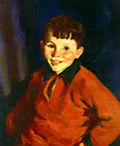The Henris left Achill at the end of September 1913 and were not to return for another ten years. This gap can partly be explained by world events, as firstly the 1914-1918 Great War and then the Irish Civil War would have made travelling to Ireland seem dangerous to the Americans. In the intervening years Robert Henri made several trips to southern California and Santa Fe, New Mexico, where he painted portraits of native Mexicans, his choice of subject matter again reflecting his belief that art should express humanity and character rather than class and refined taste. This attitude had encouraged a number of American artists and writers to travel to Santa Fe and Taos in New Mexico to experience the indigenous culture. Painter Georgia O'Keefe and photographer Paul Strand were both based in New Mexico at this time, and ten years later the Castlebar-born Irish rebel leader Ernie O'Malley would enjoy the creative environment in Taos as he began writing his memoirs.
Robert and Marjorie Henri returned to Achill Island in March 1924 after spending eight months in Spain, and again they rented Corrymore House, this time for the sum of one pound a week. Towards the end of their 1924 visit, in November, the Henris bought Corrymore House along with 15 acres of land for £200 ($870). During this visit Robert Henri would split his time between painting and fishing for trout on Corrymore and Keel lakes. He continued to paint local people, with the Lavelle and Cafferkey families from The Brae, Dooagh, particular favourites. Other models mentioned by Robert Henri included Mary O'Malley, Birdeen (Birdeen McNamara) and Michael McNamara. Henri referred to his models as 'my people', a phrase which reflected his belief in art expressing universal values. As he explained:
..."My love of mankind is individual. I am patriotic only about what I admire, and my devotion to humanity burns as brightly for Europe as for America. It flames up swiftly for Mexico if I am painting the peon there; it warms towards the bull fighter of Spain if in spite of its cruelty there is that element in his art which I find beautiful; it intensifies before the Irish peasant whose love, poetry, simplicity, and humour have enriched my existence just as completely as though these people were of my own country and my own hearthstone. Everywhere I see at times this beautiful expression of the dignity of life to which I respond with a wish to preserve this beauty of humanity for my friends to enjoy..."
('Henri and Manship' by Carl A. Zigrosser, in Little Review II, 1915)
The Henris returned to Achill Island each summer from 1924 to 1928, helping in their own way to boost the local economy by paying their young models half a crown, equivalent to a man's daily wage at the time. By all accounts the local children enjoyed their trips to Corrymore House to sit for Robert Henri. As well as the music, food and sweets from Marjorie, Robert Henri himself was keen to hear their stories and chatter. He wrote of his annoyance one time when a policeman visited the Corrymore House studio seeking a child who had truanted from school to sit for the artist. Henri wrote: "...I must have models. The few days that any one child comes up here are certainly more educational than the days they lose at school by so doing". (Robert Henri diary, July 26, 1928) Robert Henri's workrate on Achill was prodigious, and during the summer of 1927 and again in 1928 he produced some 140 portraits of Achill people. At the end of each summer a local man, Johnny Tom Owen McNamara, would pack and crate Henris canvasses ready for shipment to the States. Johnny Tom Owen had been a close companion of Paul Henry during the Irish artist's residence on Achill between 1909 and 1919, and in later years the responsibility of packing Robert Henris work passed to his nephew, John Pat Tom Owen. In September 1928 a violent storm caught Robert Henri while he was out fishing on Keel lake, and he suffered a severe cold. He blamed this cold for an attack of neuritis that struck during his return voyage to New York. On his arrival there he entered hospital, where tests revealed to doctors that Robert Henri had terminal cancer. He was never informed of his true condition, and died in July 1929. His legacy to Achill Island is the hundreds of portraits of local people, particularly children, that are housed in public and private art collections across the world.


